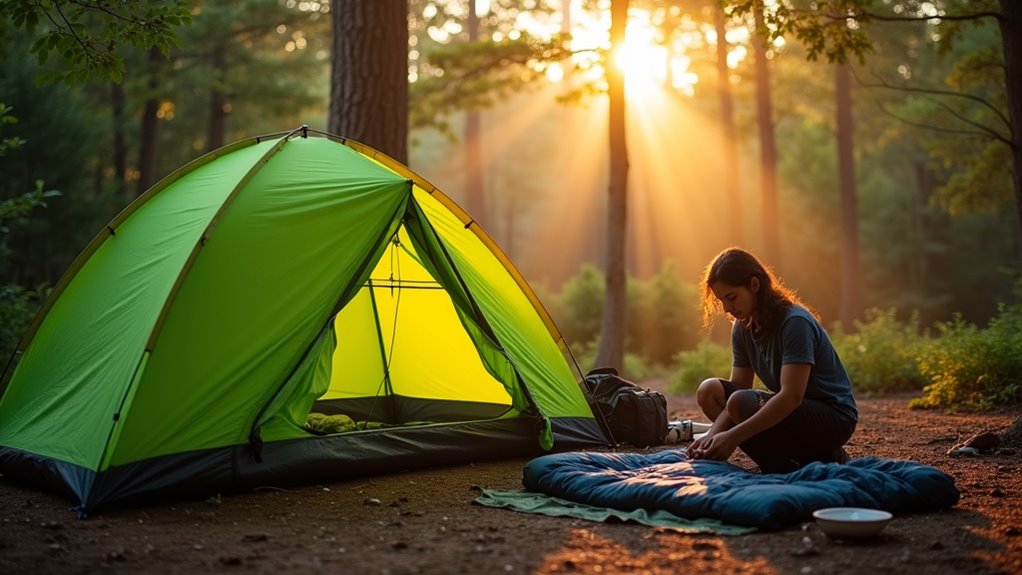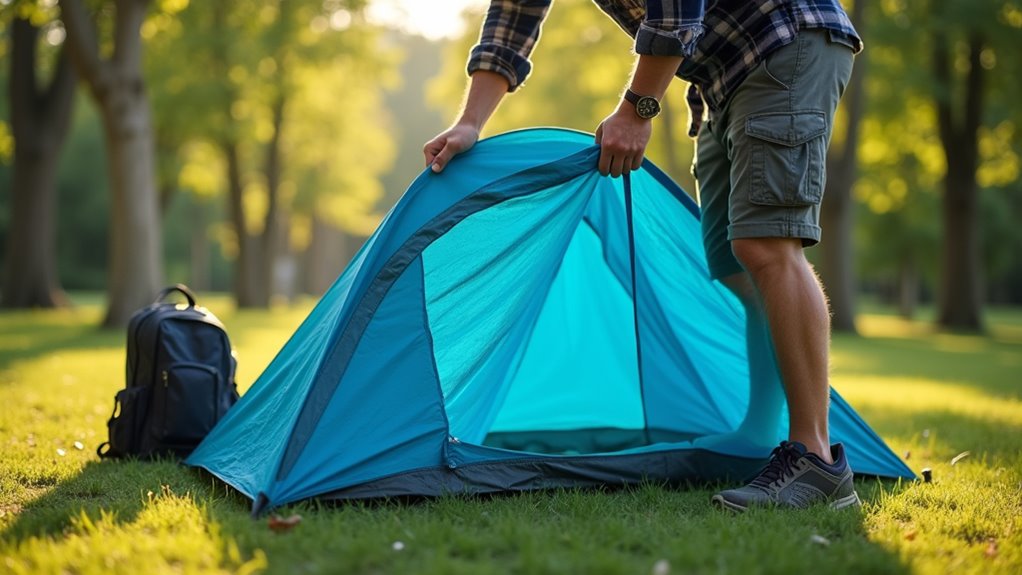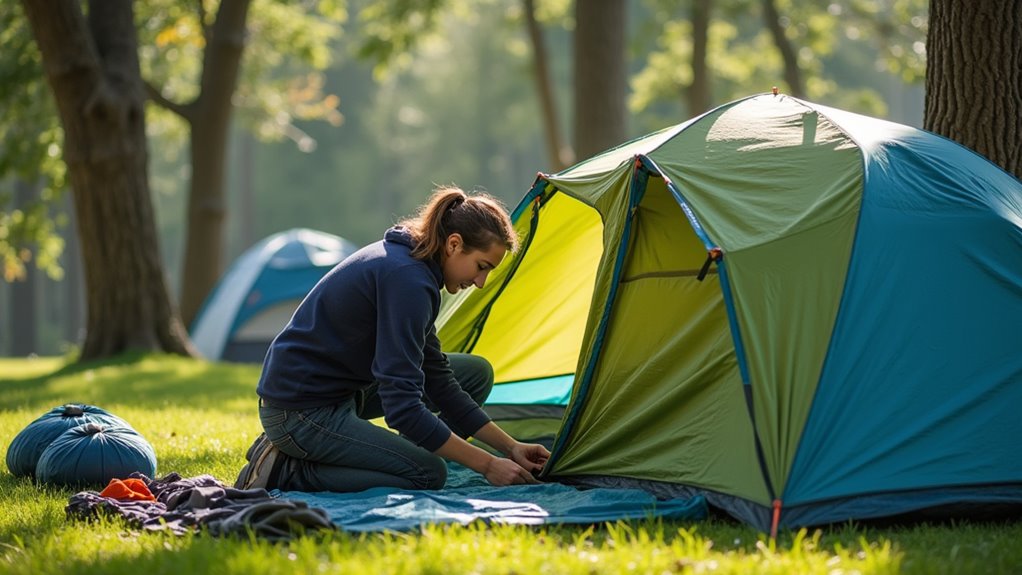How To Fold The Tent
This post contains affiliate links. As an Amazon Associate, we earn from qualifying purchases.
To fold your tent properly, first clean and dry it, then remove stakes and poles before laying it flat. Close all zippers, fold the tent lengthwise, and then fold it into thirds or quarters; do the same for the rainfly by folding it lengthwise and rolling it tightly. Finally, pack everything into a compression bag for easy storage. Further details and tips on folding your tent effectively are provided below for those who want to learn more.
Essential Facts in 30 Seconds
- Ensure the tent is clean and dry before folding to prevent mold.
- Remove stakes, rainflies, and fold poles carefully.
- Lay the tent flat, close zippers, and fold edges toward the center.
- Fold the tent into thirds or quarters, tucking in vestibules.
- Store tent parts separately in labeled bins for organization.
Preparation Before Folding a Tent

Preparing your tent before folding keeps it in great shape for next time. Start by cleaning off dirt, leaves, and small debris. Use a soft brush or cloth to wipe away dust and mud gently. Avoid strong soaps that can harm waterproof parts. Mild soap works best if you need it.
Check zippers carefully. Remove any sand or grit to stop jams.
Dry your tent well. Put it up in a sunny, airy spot but not under harsh sun for too long. Use towels to soak up wet areas inside. Make sure the tent is fully dry before folding. Wet fabric can cause mold and bad smells. Proper drying techniques help to ensure that your tent remains in good condition for future use.
Look closely at all corners and seams for damp spots. Folding the tent while it is still completely dry is essential to prevent mildew. This care helps your tent last longer and stay ready for adventures.
Tent Disassembly Steps
Disassembling your tent helps it last longer and stay ready for trips. First, pull out all stakes or pegs from the ground. Untie or unhook the guy lines before lifting stakes straight up. Keep the stakes in a bag to carry easily. Check the ground for any sharp objects left behind.
Next, take off rainflies, sidewalls, or other tent parts. Unzip sidewalls and fold the rainfly carefully to avoid tears. It is important to remove the rainfly to ensure that it stays in good condition.
Find the tent frame release points. Gently fold the poles to avoid bending them. Make the tent legs as short as possible, then fold them inward. Be sure to pack stakes and poles separately for quick access in the future.
Pack the tent fabric and all parts into the carry bag. Close the bag tightly to keep everything safe. This routine protects your tent and keeps it ready for your next adventure.
Folding the Tent Body

Fold the tent body carefully to keep it compact and ready for use.
Lay the tent flat on a clean surface. Make sure the fabric is smooth and wrinkle-free. Close all zippers. Line up the tent doors so the tent folds evenly.
Fold one edge toward the center. Then fold the opposite side to make a narrow rectangle. Fold this rectangle into thirds or quarters. Match the width to your folded tent poles. Keep the folds tight. To ensure a smooth folding process, remove any stakes or guylines before starting.
Tuck in any vestibules to reduce bulk. Stack multiple parts evenly. Check that each layer lines up well.
Remove dirt and debris before folding. Make sure the tent is dry and clean. This keeps your tent strong and lasts longer. Additionally, ensure the area around the tent is clear of debris or sharp objects before starting the folding process.
Folding and Rolling the Rainfly
Prepare a clean, dry surface for folding your rainfly. Remove all guylines, Velcro, and hooks first. Make sure the rainfly is completely dry to stop mold growth, as moisture can lead to mildew.
Spread it flat and smooth out any wrinkles. Fold the rainfly lengthwise into halves or thirds. Match the edges carefully for a neat fold. Tuck all attachments inside to keep them from tangling.
Start rolling from the narrow end with steady pressure. This keeps the roll tight and stops air pockets. Rolling also helps avoid creases that may damage the fabric. Remember to address any damage to the rainfly before packing to ensure longevity.
Use straps to hold the roll together during transport. This way, your rainfly stays in good shape and is ready for your next trip.
Efficient Packing and Storage Tips

Packing and storing your tent well helps it last longer and stay in good shape.
First, take out all stakes and poles. This cuts down on bulk and stops damage.
Fold the tent along its natural seams. Press out air and wrinkles to make it flat. Fold the tent lengthwise, then widthwise into a small rectangle. Additionally, ensure the tent is dry before packing to avoid mildew.
Use compression bags made for tents. These bags shrink the tent and keep it dry. Label each bag for easy finding.
Keep tent parts in clear, labeled bins. Store the tent in strong, airtight boxes to keep out bugs and moisture. Additionally, always remember to confirm the tent is empty before packing to ensure you don’t leave any gear behind.
Always make sure the tent is clean and dry before packing. This stops mildew and bad smells.
Following these tips keeps your tent ready for your next trip.
Frequently Asked Questions
How Often Should I Clean My Tent Before Folding?
Clean your tent after every trip, especially if it gets muddy or wet. Dirt and grime can damage the fabric over time. Regular cleaning keeps your tent strong and ready for many adventures. Use a soft brush and mild soap with water. Avoid harsh chemicals that harm the material. Let your tent dry completely before folding it. This prevents mold and bad smells. Taking good care of your tent saves money and ensures it lasts longer.
Can I Fold My Tent When It’s Still Wet?
Folding a wet tent can cause problems. Wet tents hold moisture inside the fabric. This moisture can lead to mold and bad smells. It can also damage the tent’s material over time. To keep your tent safe, try to dry it first. Spread the tent out in the sun or hang it in a dry place. If you must pack it wet, fold it loosely. Open it up to air out as soon as you can. Taking these steps helps your tent last longer and stay fresh.
What Should I Do if My Tent Has a Tear?
A tear in your tent needs quick fixing to keep it dry and safe. Start by cleaning the torn area well. Use a waterproof patch for small holes. For bigger tears, sewing adds extra strength. Let the patch or stitches dry completely before using the tent again. This keeps your shelter strong and ready for your next adventure.
Is It Necessary to Fold the Tent Poles Separately?
Folding tent poles separately helps keep them safe from damage. It stops the poles from bending or breaking. This method also makes packing your gear easier. Proper folding keeps poles strong for many trips. Taking care of your poles saves money on replacements. Simple folding means your tent sets up faster next time. Always fold poles one by one for the best results.
How Can I Prevent My Tent From Getting Damaged During Storage?
Treat your tent like a fragile flower. Keep it completely dry before storing. Store it in a cool, dry place with good air flow. Use a breathable bag to stop moisture and pests. Moisture causes mold and fabric damage. Good air flow helps keep your tent fresh. Avoid storing tents in plastic bags for a long time. This traps moisture and harms the material. Check your tent for dirt or bugs before packing. Clean tents last longer and stay strong. Following these steps protects your tent for many camping trips.
Conclusion
Fold your tent carefully to make storage and transport easier. Treat this step as a gentle goodbye to your outdoor home. Follow the steps to keep your tent in good shape for many trips. A well-folded tent saves space and speeds up setup next time. Take your time. Smooth folds help avoid damage and dirt. Store your tent in a dry place. This keeps fabric strong and prevents mold. A neat fold means your tent lasts longer and stays ready for adventure.
